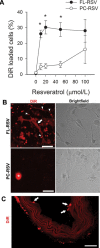Resveratrol encapsulated in novel fusogenic liposomes activates Nrf2 and attenuates oxidative stress in cerebromicrovascular endothelial cells from aged rats
- PMID: 24642904
- PMCID: PMC4351387
- DOI: 10.1093/gerona/glu029
Resveratrol encapsulated in novel fusogenic liposomes activates Nrf2 and attenuates oxidative stress in cerebromicrovascular endothelial cells from aged rats
Abstract
Resveratrol (3,4',5-trihydroxystilbene) is a plant-derived polyphenolic trans-stilbenoid, which exerts multifaceted antiaging effects. Here, we propose a novel delivery system for resveratrol, which significantly increases its cellular uptake into aged cells. Combination of resveratrol with a positively charged lipid component to "conventional" liposomes converts these lipid vesicles to a robust fusogenic system. To study their cellular uptake and cellular effects, we treated primary cerebromicrovascular endothelial cells isolated from aged F344xBN rats with resveratrol encapsulated in fusogenic liposomes (FL-RSV). To demonstrate effective cellular uptake of FL-RSV, accumulation of the lipophilic tracer dye, DiR, and resveratrol in cerebromicrovascular endothelial cells was confirmed using flow cytometry and confocal microscopy and high-performance liquid chromatography electrochemical detection. Treatment of aged cerebromicrovascular endothelial cells with FL-RSV activated Nrf2 (assessed with a reporter gene assay), significantly decreased cellular production of reactive oxygen species (assessed by a flow cytometry-based H2DCFDA fluorescence method), and inhibited apoptosis. Taken together, encapsulation of resveratrol into novel fusogenic liposomes significantly enhances the delivery of resveratrol into aged cells, which subsequently results in rapid activation of cellular Nrf2-driven antioxidant defense mechanisms. Our studies provide proof-of-concept for the development of a novel, translationally relevant interventional strategy for prevention and/or control of oxidative stress-related pathophysiological conditions in aging.
Keywords: Endothelial; Fusogenic liposomes; Oxidative stress; Polyphenol..
© The Author 2014. Published by Oxford University Press on behalf of The Gerontological Society of America. All rights reserved. For permissions, please e-mail: journals.permissions@oup.com.
Figures






Similar articles
-
Fusogenic liposomes effectively deliver resveratrol to the cerebral microcirculation and improve endothelium-dependent neurovascular coupling responses in aged mice.Geroscience. 2019 Dec;41(6):711-725. doi: 10.1007/s11357-019-00102-1. Epub 2019 Oct 25. Geroscience. 2019. PMID: 31654270 Free PMC article.
-
Resveratrol confers endothelial protection via activation of the antioxidant transcription factor Nrf2.Am J Physiol Heart Circ Physiol. 2010 Jul;299(1):H18-24. doi: 10.1152/ajpheart.00260.2010. Epub 2010 Apr 23. Am J Physiol Heart Circ Physiol. 2010. PMID: 20418481 Free PMC article.
-
Lung endothelial barrier protection by resveratrol involves inhibition of HMGB1 release and HMGB1-induced mitochondrial oxidative damage via an Nrf2-dependent mechanism.Free Radic Biol Med. 2015 Nov;88(Pt B):404-416. doi: 10.1016/j.freeradbiomed.2015.05.004. Epub 2015 May 13. Free Radic Biol Med. 2015. PMID: 25979658
-
Role of resveratrol in regulation of cellular defense systems against oxidative stress.Biofactors. 2018 Jan;44(1):36-49. doi: 10.1002/biof.1399. Epub 2017 Nov 28. Biofactors. 2018. PMID: 29193412 Review.
-
Mitochondrial protection by resveratrol.Exerc Sport Sci Rev. 2011 Jul;39(3):128-32. doi: 10.1097/JES.0b013e3182141f80. Exerc Sport Sci Rev. 2011. PMID: 21383627 Free PMC article. Review.
Cited by
-
Reduced Dynamic Coupling Between Spontaneous BOLD-CBF Fluctuations in Older Adults: A Dual-Echo pCASL Study.Front Aging Neurosci. 2018 Apr 23;10:115. doi: 10.3389/fnagi.2018.00115. eCollection 2018. Front Aging Neurosci. 2018. PMID: 29740310 Free PMC article.
-
The Cognitive Restoration Effects of Resveratrol: Insight Molecular through Behavioral Studies in Various Cognitive Impairment Models.ACS Pharmacol Transl Sci. 2024 Oct 10;7(11):3334-3357. doi: 10.1021/acsptsci.4c00373. eCollection 2024 Nov 8. ACS Pharmacol Transl Sci. 2024. PMID: 39539271 Review.
-
The role of Nrf2 signaling in counteracting neurodegenerative diseases.FEBS J. 2018 Oct;285(19):3576-3590. doi: 10.1111/febs.14379. Epub 2018 Jan 29. FEBS J. 2018. PMID: 29323772 Free PMC article. Review.
-
Fusogenic liposomes effectively deliver resveratrol to the cerebral microcirculation and improve endothelium-dependent neurovascular coupling responses in aged mice.Geroscience. 2019 Dec;41(6):711-725. doi: 10.1007/s11357-019-00102-1. Epub 2019 Oct 25. Geroscience. 2019. PMID: 31654270 Free PMC article.
-
Nanodelivery of phytobioactive compounds for treating aging-associated disorders.Geroscience. 2020 Feb;42(1):117-139. doi: 10.1007/s11357-019-00116-9. Epub 2019 Nov 4. Geroscience. 2020. PMID: 31686375 Free PMC article. Review.
References
-
- Lagouge M, Argmann C, Gerhart-Hines Z, et al. Resveratrol improves mitochondrial function and protects against metabolic disease by activating SIRT1 and PGC-1alpha. Cell. 2006;127:1109–1122. - PubMed
-
- Ungvari Z, Orosz Z, Labinskyy N, et al. Increased mitochondrial H2O2 production promotes endothelial NF-kappaB activation in aged rat arteries. Am J Physiol Heart Circ Physiol. 2007;293:H37–H47. - PubMed
Publication types
MeSH terms
Substances
Grants and funding
LinkOut - more resources
Full Text Sources
Other Literature Sources
Medical

